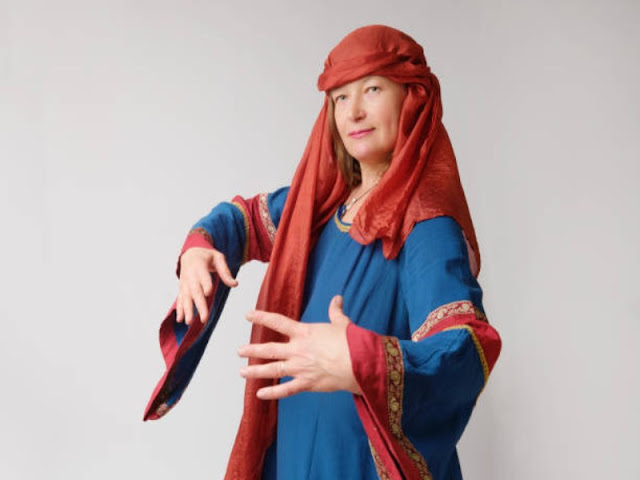
A Glimpse into the 12th and 13th Centuries
The concept of elegance in the Middle Ages, particularly
during the 12th and 13th centuries, was intrinsically linked to aristocratic
preferences for enhancing beauty and displaying refinement. This era witnessed
the emergence of a distinct aristocratic culture that emphasized luxury,
sophistication, and an intricate relationship between aesthetics and social
status. In this exploration, we delve into the development of aristocratic
elegance during these centuries, shedding light on the extravagant sartorial
choices, refined manners, and evolving notions of beauty that characterized
this fascinating period.
The Rise of Aristocratic Elegance
The 12th and 13th centuries in Europe marked a significant
shift from the earlier, more rudimentary styles of the Middle Ages. This
transition was driven by a variety of factors, including economic prosperity,
cultural exchanges with the Byzantine and Islamic worlds, and the increasing
availability of luxury goods. Aristocratic elegance began to take shape as
European nobility sought to distinguish themselves from the lower classes and
neighboring regions.
Luxurious Fabrics and Clothing
One of the defining features of aristocratic elegance in the
Middle Ages was the extensive use of luxurious fabrics and sumptuous clothing.
Aristocrats were drawn to opulent materials, such as silks, brocades, velvets,
and damasks, which were often imported from the East. These fabrics were prized
not only for their exquisite textures but also for their vivid colors and
intricate patterns.
- Robes
and Gowns: Aristocratic men and women donned elaborate robes and
gowns. These garments featured a profusion of folds, drapes, and layers,
often accompanied by extravagant sleeves and trains. The use of fine
fabrics and intricate embroidery transformed clothing into a canvas for
artistic expression.
- Colors
and Dyeing Techniques: Rich, deep colors were highly sought after,
including deep blues, purples, and reds. Achieving these colors was a
complex process that often involved multiple dyeing stages and the use of
costly materials. The rarity of certain dyes, such as Tyrian purple,
contributed to their exclusivity.
Refined Manners and Courtly Behavior
Aristocratic elegance extended beyond clothing and
encompassed refined manners and courtly behavior. The chivalric code and
courtly love were pivotal in shaping the conduct of aristocrats during this
era.
- Chivalry:
The code of chivalry emphasized virtues such as courage, loyalty, and
courtesy. Knights and nobles were expected to display these qualities, and
courteous behavior was integral to an aristocrat's identity.
- Courtly
Love: The concept of courtly love encouraged noble men to engage in
idealized, often platonic, relationships with noble women. This notion of
love was steeped in reverence and courtesy, further emphasizing the
importance of refined behavior.
Elaborate Accessories and Adornments
Accessories and adornments were a key element of
aristocratic elegance. Aristocrats adorned themselves with precious gems,
metals, and ornate accessories, which served as both status symbols and
expressions of personal style.
- Jewelry:
Rings, brooches, pendants, and diadems were adorned with gems, pearls, and
intricate enamel work. Jewelry often served as a display of wealth and
power, with gemstones symbolizing social standing.
- Headdresses:
Elaborate headdresses and head coverings were prevalent, particularly
among noblewomen. These headpieces were often studded with jewels and
featured veils, wimples, and other decorative elements.
Challenges and Paradoxes
While aristocratic elegance was characterized by luxury and
refinement, it also carried with it certain challenges and paradoxes:
- Economic
Burdens: Maintaining an elegant lifestyle was costly, and the
acquisition of luxury goods, fine clothing, and precious jewelry placed a
heavy financial burden on aristocrats. This sometimes led to financial
instability and indebtedness.
- Exclusivity
and Inequality: Aristocratic elegance often perpetuated social
inequalities, as only the nobility could afford such extravagance. The
exclusivity of luxury goods and refined manners contributed to the
widening gap between the aristocracy and the common people.
Influences and Legacy of Aristocratic Elegance
The concept of aristocratic elegance during the 12th and
13th centuries was shaped by a convergence of influences. These included the
Crusades, which exposed Europeans to the wealth and sophistication of the East,
as well as cultural exchanges with the Islamic and Byzantine worlds. These
interactions introduced Europeans to new fabrics, dyeing techniques, and
artistic traditions, which had a profound impact on their evolving notions of
elegance.
The legacy of aristocratic elegance is still visible in contemporary fashion and culture. While many of the sumptuous fabrics and accessories have evolved, the influence of the Middle Ages can be seen in the emphasis on opulence, attention to detail, and the enduring appeal of refined manners and courtesy. The extravagant clothing, courtly love, and chivalric ideals continue to inspire modern interpretations of elegance.
Conclusion
Aristocratic elegance in the 12th and 13th centuries was a
complex and multifaceted concept that emerged from the interplay of cultural,
economic, and social factors. The period marked a shift towards luxury,
sophistication, and refinement in clothing, behavior, and self-presentation.
The legacy of this elegance is not only a testament to the opulence of the
Middle Ages but also a source of inspiration for contemporary notions of style
and conduct. Aristocratic elegance serves as a reminder of the enduring human
fascination with beauty, luxury, and the pursuit of refinement in both attire
and manners.